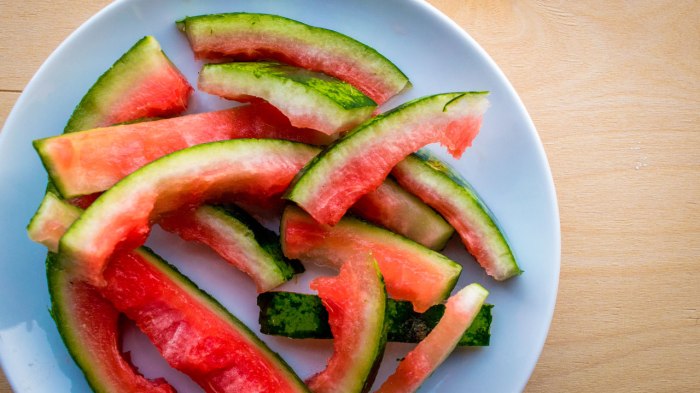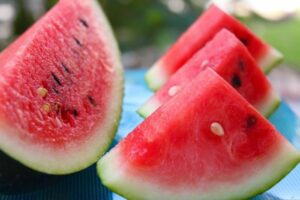Can you eat the rind of a watermelon? The answer may surprise you! Often discarded as waste, the watermelon rind holds a wealth of nutritional value and culinary potential, inviting us to rethink our fruit consumption habits.
From its impressive nutrient profile to its unique flavor and texture, the watermelon rind offers a range of benefits and culinary possibilities that are sure to tantalize your taste buds and enhance your overall well-being.
Nutritional Value of Watermelon Rind

The rind of a watermelon, often discarded as waste, is surprisingly packed with essential nutrients. It contains a significant amount of vitamins, minerals, and antioxidants that can provide various health benefits.
Compared to the flesh of the watermelon, the rind has a higher concentration of certain nutrients. For instance, it is richer in fiber, vitamin C, and potassium.
Vitamin C
Watermelon rind is an excellent source of vitamin C, an essential nutrient for immune function, skin health, and collagen production.
Potassium, Can you eat the rind of a watermelon
The rind is also a good source of potassium, a mineral that helps regulate blood pressure, fluid balance, and muscle function.
Fiber
The fiber content in the rind promotes digestive health, regulates blood sugar levels, and provides a feeling of fullness.
Antioxidants
Watermelon rind contains various antioxidants, including citrulline, lycopene, and cucurbitacin, which protect cells from damage caused by free radicals.
Health Benefits of Eating Watermelon Rind

Beyond its juicy flesh, the rind of a watermelon also holds an array of nutritional benefits. Consuming this often-discarded part of the fruit can provide a wealth of health-promoting compounds.
Improved Digestion
Watermelon rind is a rich source of dietary fiber, which is essential for maintaining a healthy digestive system. Fiber helps to regulate bowel movements, prevent constipation, and promote overall gut health.
Reduced Inflammation
The rind of a watermelon contains antioxidants and anti-inflammatory compounds, such as cucurbitacin and citrulline. These compounds have been shown to reduce inflammation throughout the body, which can help alleviate conditions such as arthritis and asthma.
Boosted Immunity
Watermelon rind is a good source of vitamin C, an essential nutrient for a healthy immune system. Vitamin C helps to protect the body from infections and diseases by supporting the production of white blood cells.
Culinary Uses of Watermelon Rind
Beyond its refreshing and juicy flesh, the rind of a watermelon offers a treasure trove of culinary possibilities. Its unique texture and subtly sweet flavor make it a versatile ingredient that can be incorporated into a wide range of dishes, adding a touch of both nutrition and creativity.
Whether you prefer to pickle it, stir-fry it, or transform it into a refreshing salad, watermelon rind is a culinary chameleon that can adapt to various cooking methods and flavors. Its firm texture holds its shape well during cooking, making it an excellent choice for grilling or roasting. The mild sweetness of the rind complements both savory and sweet dishes, providing a delicate balance of flavors.
Recipes and Nutritional Information
Here’s a table showcasing some creative and nutritious recipes featuring watermelon rind:
| Recipe | Nutritional Information (per serving) |
|---|---|
| Watermelon Rind Pickles | Calories: 15, Carbohydrates: 4g, Sugar: 3g, Fiber: 1g, Vitamin C: 10mg |
| Stir-Fried Watermelon Rind with Ginger and Garlic | Calories: 50, Carbohydrates: 10g, Sugar: 5g, Fiber: 2g, Vitamin C: 20mg |
| Watermelon Rind Salad with Feta and Mint | Calories: 70, Carbohydrates: 15g, Sugar: 10g, Fiber: 3g, Vitamin C: 30mg |
| Watermelon Rind Chutney | Calories: 40, Carbohydrates: 8g, Sugar: 6g, Fiber: 1g, Vitamin C: 15mg |
| Grilled Watermelon Rind Skewers | Calories: 30, Carbohydrates: 5g, Sugar: 2g, Fiber: 1g, Vitamin C: 10mg |
Safety Considerations: Can You Eat The Rind Of A Watermelon

When incorporating watermelon rind into your diet, certain safety considerations should be kept in mind. These include choosing organic or pesticide-free watermelons, as well as employing proper storage and handling techniques.
Choosing Organic or Pesticide-Free Watermelons
Conventional farming practices often involve the use of pesticides to protect crops from pests and diseases. While these chemicals are necessary for agricultural productivity, they can leave residues on the rind of watermelons. Consuming these residues can pose potential health risks, including:
- Increased risk of cancer
- Hormonal imbalances
- Neurological problems
To minimize exposure to harmful chemicals, it is advisable to choose organic or pesticide-free watermelons whenever possible. Organic farming methods prohibit the use of synthetic pesticides, ensuring that the rind is safe for consumption.
Proper Storage and Handling
Proper storage and handling techniques are crucial to maintain the freshness and safety of watermelon rind. Here are some key guidelines:
- Store in a cool, dry place: Watermelon rind should be stored in a cool, dry environment to prevent spoilage. Refrigeration is ideal, with temperatures between 32-40°F (0-4°C) being optimal.
- Avoid prolonged storage: Watermelon rind is best consumed within a few days of cutting. Prolonged storage can lead to the growth of bacteria and mold, making it unsafe for consumption.
- Wash thoroughly before eating: Before consuming watermelon rind, it is essential to wash it thoroughly with clean water to remove any surface contaminants.
By following these safety considerations, you can enjoy the nutritional benefits of watermelon rind with peace of mind.
Sustainability and Environmental Impact
Consuming watermelon rind offers significant environmental benefits, contributing to a more sustainable and eco-friendly lifestyle.
One major advantage is the reduction of food waste. Watermelon rinds, which constitute approximately 40% of the fruit, are often discarded, leading to a substantial waste of valuable nutrients and resources.
Reducing Food Waste
- Incorporating watermelon rind into the diet reduces the amount of food that is wasted, contributing to a more sustainable food system.
- Utilizing all parts of the watermelon promotes efficient use of resources and minimizes the environmental impact associated with food production.
Sustainable Farming Practices
- Encouraging the consumption of watermelon rind supports sustainable farming practices.
- When farmers know that the entire watermelon can be utilized, they are more likely to grow watermelons using environmentally friendly methods.
Conclusive Thoughts
Whether you’re seeking to reduce food waste, improve your health, or simply expand your culinary horizons, incorporating watermelon rind into your diet is a smart and delicious choice. Embrace the versatility of this often-overlooked fruit component and unlock a world of flavor, nutrition, and sustainability.
FAQ Explained
Is the watermelon rind safe to eat?
Yes, the watermelon rind is generally safe to eat and offers several nutritional benefits.
What are the health benefits of eating watermelon rind?
Watermelon rind is rich in vitamins, minerals, and antioxidants, which may support digestion, reduce inflammation, and boost immunity.
How can I incorporate watermelon rind into my diet?
Watermelon rind can be eaten raw, pickled, or cooked in various dishes, such as salads, soups, and stir-fries.
Is watermelon rind a good source of fiber?
Yes, watermelon rind is a good source of dietary fiber, which is important for digestive health and satiety.
How should I store watermelon rind?
Store watermelon rind in the refrigerator for up to 3 days. To extend its shelf life, freeze it for up to 6 months.







Leave a Comment